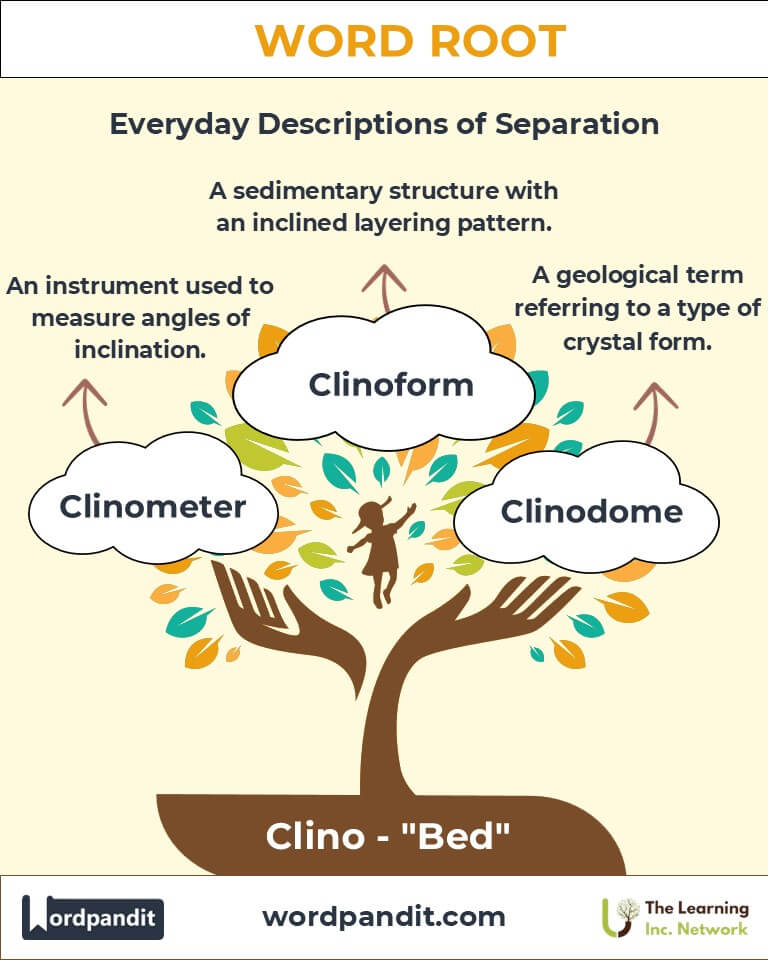clino," meaning "bed" or "to lean." Pronounced "kly-noh," this root captures the essence of rest, support, and angles, giving rise to words that serve diverse

Table of Contents
- Introduction: The Essence of "Clino"
- Etymology and Historical Journey
- Mnemonic: Unlocking the Power of "Clino"
- Common "Clino"-Related Terms
- "Clino" Through Time
- "Clino" in Specialized Fields
- Illustrative Story: "Clino" in Action
- Cultural Significance of the "Clino" Root
- The "Clino" Family Tree
- FAQs about the "Clino" Word Root
- Test Your Knowledge: "Clino" Mastery Quiz
- Conclusion: The Restful Legacy of "Clino"
Introduction: The Essence of "Clino"
What do a hospital bed and a geological instrument have in common? Both stem from the root "clino," meaning "bed" or "to lean." Pronounced "kly-noh," this root captures the essence of rest, support, and angles, giving rise to words that serve diverse roles in healthcare, science, and everyday life. Whether describing the clinical nature of a hospital or the precise angle measured by a clinometer, "clino" forms a linguistic bridge between rest and inclination.

Etymology and Historical Journey
The root "clino" has its origins in the Greek word klinein (to lean or recline) and the Latin clinare (to bend or incline). In ancient Greece, the term was closely associated with rest and support, as seen in the klinē, or couch. Over centuries, the root expanded its reach, evolving into modern English words that describe both physical and metaphorical leaning or support. Its journey from classical languages into English reflects humanity’s universal experiences of rest and inclination.
Mnemonic: Unlocking the Power of "Clino"
Imagine a reclining chair labeled "CLINO" that adjusts to the perfect angle, symbolizing both rest and inclination. This vivid image ties the root to its dual meanings.
Mnemonic Device: "Clino reclines into rest and leans into precision."
Common "Clino"-Related Terms
- Clinical (klin-ih-kuhl): Related to a bed or medical care.
Example: "The clinical setting of the hospital ensures patient comfort and care."
- Clinometer (kly-nom-uh-ter): An instrument used to measure angles of inclination.
Example: "Surveyors used a clinometer to assess the slope of the land."
- Decline (dih-klahyn): To lean downward or decrease in value.
Example: "The market saw a sharp decline in prices last week."
- Inclination (in-kluh-ney-shun): A leaning toward an idea, behavior, or position.
Example: "Her inclination toward art was evident in her early sketches."
- Recline (ri-klahyn): To lean back or rest in a lying position.
Example: "She reclined in the chair, enjoying the afternoon sun."
"Clino" Through Time
- Clinical: Originally describing anything related to a bed, it now focuses on the medical field.
Shift: From physical rest to metaphorical support and care. - Clinometer: Developed during the Renaissance for navigation and surveying.
Evolution: From a maritime tool to a modern geoscience instrument.
"Clino" in Specialized Fields
- Healthcare:
- Clinical: Refers to the observation and treatment of patients.
- Importance: Ensures evidence-based medical practices.
- Geoscience:
- Clinometer: Measures angles of geological formations.
- Application: Vital for understanding slopes and tectonic shifts.
- Astronomy:
- Inclination: Describes the tilt of a celestial body’s orbit.
- Impact: Helps calculate planetary positions and trajectories.
Cultural Significance of the "Clino" Root
The root "clino" resonates deeply in both metaphorical and literal contexts. From ancient Greek couches symbolizing hospitality to modern clinical settings ensuring health, "clino" reflects humanity’s universal need for rest and balance. Its presence in diverse fields highlights its enduring relevance.
Illustrative Story: "Clino" in Action
Dr. Elena, a geologist, used her clinometer to measure the steepness of a rock face. Meanwhile, in a nearby clinic, her sister Maria adjusted a patient's bed to ensure comfort during recovery. Although worlds apart, both sisters relied on the power of "clino"—one to measure precision in nature, the other to provide rest and healing.

The "Clino" Family Tree
- Incline (Latin clinare): To lean or slope upward.
Example: "The steep incline made the hike challenging." - Declension (Latin declinare): A downward bending or grammatical inflection.
Example: "Latin verbs follow specific declensions based on tense and case." - Acclimate (Latin adclinare): To adapt to a leaning or surrounding.
Example: "Travelers need time to acclimate to high altitudes."
Illustrative Story: "Clino" in Action
Dr. Elena, a geologist, used her clinometer to measure the steepness of a rock face. Meanwhile, in a nearby clinic, her sister Maria adjusted a patient's bed to ensure comfort during recovery. Although worlds apart, both sisters relied on the power of "clino"—one to measure precision in nature, the other to provide rest and healing.
FAQs About the Clino Word Root
Q: What does "clino" mean?
A: "Clino" means "bed" or "to lean," derived from the Greek klinein and Latin clinare. It symbolizes concepts of rest, support, and inclination. This root appears in various contexts, from describing physical positioning (e.g., reclining) to metaphorical leaning, as in an inclination toward an idea.
Q: What is a clinometer, and what is it used for?
A: A clinometer is an instrument used to measure angles of inclination, such as slopes, heights, or elevation changes. It is widely employed in geoscience, navigation, and construction to ensure precision in measuring gradients or the tilt of structures.
Q: How is the word "clinical" connected to "clino"?
A: The term "clinical" originates from the Greek klinē, meaning "bed." Initially referring to activities or observations related to a sickbed, it now broadly encompasses anything related to medical care, such as clinical trials or hospital environments.
Q: What is the difference between inclination and declination?
A:
Inclination: Refers to a tendency to lean upward or metaphorically lean toward something, such as a preference or disposition.
Declination: Indicates a downward leaning, physical or metaphorical, such as the declining popularity of an idea or a celestial object's angle below a reference plane.
Q: Why is the root "clino" significant in astronomy?
A: In astronomy, "clino" appears in the term "inclination," which describes the tilt of a celestial object’s orbit relative to a reference plane, such as the ecliptic. This measure is critical for understanding orbital mechanics and celestial alignments.
Q: Can "clino" describe abstract ideas, or is it purely physical?
A: While "clino" often refers to physical leaning or positioning, it also extends metaphorically to describe tendencies, preferences, or inclinations in behavior or thought. For example, an inclination toward art reflects a leaning disposition rather than a physical action.
Q: What is the relationship between recline, decline, and incline?
A:
Recline: To lean backward or lie down, often associated with rest or relaxation.
Decline: To lean downward or show a decrease, often used metaphorically to describe deterioration or refusal.
Incline: To lean or slope upward, or to show a tendency toward a certain direction, either physically or metaphorically.
Test Your Knowledge: Clino Mastery Quiz
1. What does the root "clino" signify?
2. Which term refers to measuring slopes?
3. What does "clinical" primarily relate to?
4. What does "inclination" mean in astronomy?
5. Which word describes leaning backward?

Conclusion: The Restful Legacy of "Clino"
The root "clino" bridges the domains of rest and precision, shaping words that resonate in healthcare, science, and daily life. Whether guiding the care of patients or measuring the angles of mountains, "clino" reflects humanity’s timeless need for balance and understanding. Its legacy endures, inspiring us to lean into the wonders of language and life.











